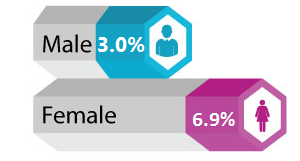Jordanian Women’s Report on the occasion of the International Women’s Day – Statistical Perspective
The Department of Statistics (DoS) has always given due importance to statistics on the social, economic and political role of women in the Jordanian society by providing the official figures and statistics to the planners and policy makers on all issues related to women noting that Jordanian women receive this occasion with a considerable number of achievements. The (DoS) views this occasion with special interest, which falls on the 8th of March each year, because women constitute about half of the Jordanian society.
In 2017, the total number of females in Jordan amounted to 4.7 million of the total population (at a rate of 47.1%). The figures show that for every 100 females in Jordan there are 113 males. The proportion of females under the age of 15 years is 35.6% of the total female population. In contrast, this percentage increases in the age group (15-49) years to 52.5%, then it decrease to 12% in the age group (+ 50 years).
Jordan has witnessed a tremendous development in the past few decades in the field of female education and gender equality since female education is considered to be one of the most important social rights and an important indicator of gender equality towards sustainable community development. The data of the Employment and Unemployment Survey – 2017 (2nd round) indicate that illiteracy rate among Jordanian females aged 15 years and above was 6.9%. In contrast, the percentage of educated females for the same age group was 93.1%.
Figure 1: Illiteracy Rate of Jordanian Population Age15+ Years by Sex, Second Round -2017
Source: Department of statistics, Employment and Unemployment Survey, Second Round -2017
The data of the Ministry of Education for the academic year (2016-2017) show that 49.1% of the students enrolled in the basic education stage were females and in the academic secondary education constituted more than half of the students.
As for higher education, females’ enrollment rate in universities in 2016 stood at 51.6% compared to 48.4% for males. The data indicate that females tend to enroll in the arts faculties at 53.4% versus science faculties at 46.6% and the female teaching members in the Jordanian universities constitute 25% of the total teaching members.
Another important aspect of gender justice is women’s success in accessing leadership positions and their effective contribution to public life and civil society institutions. As for women’s participation in public life, statistics for 2016 indicate that one out of every five members of the diplomatic and judicial corps is a female (20.1% and 18.9% respectively) and one in three members of the political parties is female too. Female ambassadors accounted for 11.1% in 2016(i.e., one female ambassador out of every nine appointed ambassadors).
Women’s economic participation is viewed as an important requirement in the overall development process. Data from the Employment and Unemployment Survey (2nd round) – 2017 indicate that Jordanian females participation in the labor market compared to males is weak (17.7% compared to 59.4%).
Figure 2: Economic Activity Rate of Jordanian Population Age15+ Years by Sex, Second Round -2017
Source: Department of statistics, Employment and Unemployment Survey, Second Round -2017
The data also indicate that majority of employed females were paid workers at 94.7%, while the percentage of self-employed females was 5.0% of the total working females. One of the main reasons behind the weak participation of Jordanian women in the labor market is the wage gap noting that the results of the Employment in Establishment Survey – 2015 show that the average wage for females in both the public and private sectors was JD.446 against JD.499 for males (a difference of JD.53 in favor of males).



